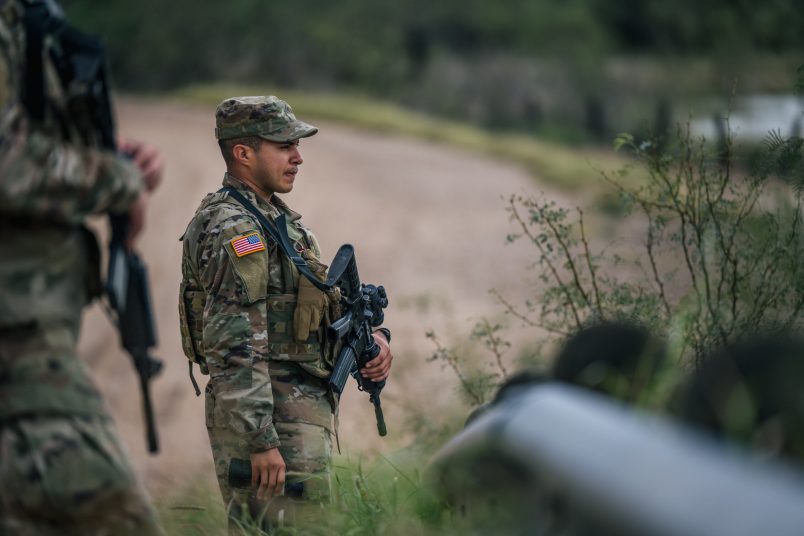The Texas lawmaker sponsoring a sweeping effort to give the state unprecedented new powers to enforce the border says that his proposal is about a few things only: fentanyl, the cartels, and saving money.
But there’s a real budgetary concern that Schaefer and other Texas lawmakers are facing as they mull what might be the most audacious anti-immigration plan contemplated by any state over the past decade.
Under Gov. Greg Abbott (R), Texas has spent more than $4 billion on state resources aimed at making a big show of providing border security. The effort, called Operation Lone Star, has seen Texas employ its National Guard to detain migrants on trespassing charges, stage shows of force along the Rio Grand, and sign nearly $900 million in contracts to build around 40 miles of border wall.
Now, Schaefer is pushing House Bill 20, a law that, if passed, would create a Border Protection Unit empowered to “repel” and “return” migrants seen crossing the border — powers normally reserved for the federal government. The unit would have criminal and civil immunity, and be able to deputize people into its ranks.
But importantly, Schaefer told local Texas media last week that he regards the bill as a potential cost-cutting measure.
“We’ve been spending billions on the border at this point,” he said, adding that it would allow the National Guard to “decrease its numbers.”
“The guard is pretty expensive, because you’re paying them per diem every day, hotels, and so there’s actually a very expensive cost that comes with the National Guard,” he said. “So in time, hopefully, this will be a more cost-effective way to address the issue.”
That’s not just puffery.
The state has been paying $2.5 million per week to keep Operation Lone Star going, Chelsie Kramer, Texas state organizer for the American Immigration Council told TPM.
The state legislature is currently hashing out the budget for the next two years, and voted out of committee this week a proposal that would give $4.6 billion across several agencies for border security efforts. That includes $1.19 billion to the Department of Public Safety, in which the Border Protection Unit would be housed.
That spending comes as federal COVID-19 aid dollars used to supplement the state’s border efforts run out.
Per the Washington Post, the Treasury Department’s inspector general is examining how Texas used federal COVID aid amid reporting that state officials used $1 billion to cover costs incurred by Operation Lone Star.
The state accomplished that by reportedly shifting public health funds to cover the border initiatives, and then using the federal COVID dollars to cover the resulting loss in public health.
Part of the funding for the Border Protection Unit will stem from its makeup, which Schaefer described as being a “mixture” of already-certified law enforcement officers and citizens called on to join the unit’s ranks.
Roberto Lopez of the Texas Civil Rights Project described it to TPM as a potential way to allow local militias, who already play in informal role in policing the border, operate under color of law. That, Lopez remarked, would be another way to defray costs.
“That way they can send home the Department of Public Safety troopers and the state national guard, and the only way to do that is by having some sort of mechanism to recruit people,” he said.
Schaefer specified that those hired would be state employees, but that it would be more cost-effective than having law enforcement officials detailed to the border, describing it as a “permanent problem, an ongoing problem and yet we have a part-time workforce.”
Schaefer’s HB 20 effort is almost certain to be challenged in the courts. A similar proposal in Arizona passed in 2010 was struck down in 2012 after the Supreme Court found that having state law enforcement arrest undocumented immigrants violated the Constitution’s supremacy clause.
When asked by one local reporter if he had considered the costs of future litigation, Schaefer shot back that it was “a cost that we’re willing to incur because we want to give Governor Abbot the maximum legal authority that we can to address a very serious problem.”
He then tacked on a segue that’s marvelous in its sheer lack of good faith: “Maybe we should talk about whats the cost to the families that have children that die of fentanyl?”







That spending comes as federal COVID-19 aid dollars used to supplement the state’s border efforts run out.
Smells like someone wants to keep a boondoggle funded.
Oh, and fr!st!
1254 miles of Texas/ Mexico border. The state has completed 1.7 miles and is negotisting for 40 more miles.
Just fyi when ya look at money spent.
There’s plenty more boon to doggle.
I ran an industrial hydraulic repair facility back in the 80s. I look at that wall and see a hydraulic jack easily opening it up in minutes. It’s laughably useless.
A State that can’t even keep the lights on is going to control the border?